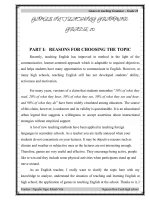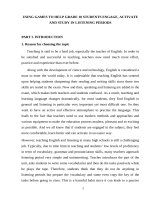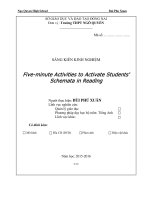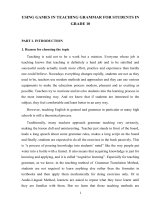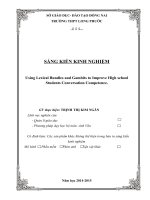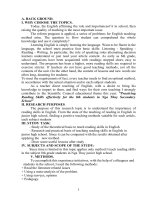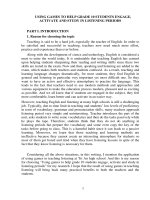skkn tiếng anh 10 USING GAMES TO HELP GRADE 10 STUDENTS ENGAGE, ACTIVATE AND STUDY IN LISTENING PERIODS
Bạn đang xem bản rút gọn của tài liệu. Xem và tải ngay bản đầy đủ của tài liệu tại đây (962.57 KB, 41 trang )
USING GAMES TO HELP GRADE 10 STUDENTS ENGAGE, ACTIVATE
AND STUDY IN LISTENING PERIODS
PART I. INTRODUCTION
1. Reason for choosing the topic
Teaching is said to be a hard job, especially the teacher of English. In order to
be satisfied and successful in teaching, teachers now need much more effort,
practice and experience than ever before.
Along with the development of cience and technology, English is considered a
must to enter the world today. It is undeniable that teaching English has centerd
upon helping students sharpening their reading and writing skills since these two
skills are tested in the exam. Now and then, speaking and listening are added to the
exam, which makes both teachers and students confused. As a result, teaching and
learning language changes dramatically, for most students, they find English in
general and listening in particular very important yet most difficult one. So they
want to have an active and effective atmostphere to practise the language. This
leads to the fact that teachers need to use modern methods and approaches and
various equipment to make the education process modern, pleasant and as exciting
as possible. And we all know that if students are engaged in the subject, they feel
more comfortable, learn better and can activate in an easier way.
However, teaching English and listening at many high schools is still a challenging
job. Typically, due to time limit in teaching and students’ low levels of proficiency
in term of vocabulary, grammar and pronunciation skills, many teachers approach
listening period very simple and uninteresting. Teacher introduces the part of the
unit, asks students to write some vocabularies and then do the tasks passively while
he plays the tape. Therefore, students think that they do not do anything in
listening periods but prepare the vocabulary and some even copy the key of the
tasks before going to class. This is a harmful habit since it can leads to a passive
1
learning. Moreover, we learn that those teaching and learning methods are
ineffective because they cannot create an interesting atmosphere for students so
most of them get bored and tired when they have listening lessons in spite of the
fact that they know listening is necessary for them.
Considering all the above situations, in this writing, I mention the application
of using games in teaching listening at Tri An high school. And this is my reason
for choosing "Using games to help grade 10 students engage, activate and study in
listening periods” for my research. I hope that the result of using games in teaching
listening will bring back many practical benefits to both the teachers and the
students.
2. Aims of the study
The major aims of the study are:
- To affirm the role of listening in teaching and learning English.
- To emphasize the importance of motivation in teaching and learning listening.
- To point out the application of games in teaching listening brings back many
benefits to students in learning listening.
- To contribute a small part to the improvement of teaching and learning at Tri An
high school.
3. Scope of the study
The benefits of using games to help grade 10 students engage, acivate and study in
listening periods create the effectiveness of students’ motivation in learning
listening and the subjects under the study are the 10 th form students at Tri A high
school (class 10A1).
2
4. Research questions
The study will help to find the answers to the following questions:
1. What are the role of listening and the importance of motivation in learning
listening?
2. What benefits can listening games bring to teachers and students?
3. What types of games should be used to help students engage, activate and study
in listening?
PART II. RATIONALE OF THE RESEARCH
1. The role of listening in teaching and learning English
While learning English, learners are faced with a large number of difficulties.
For example, they find it hard to comprehend recorded texts, direct speech, songs
or even dialogues despite the fact that they have learnt English for many years.
This is due to many factors such as the accent, the speed of speech, the falling and
rising intonation… of the native speakers. This leads to other difficulties in
3
language learning. That is the reason why students are required to be familiar with
it by listening. Therefore, listening is considered to be a basic skill in learning
English and is placed at the top of language skills. According to Doff’s viewpoint
(1988:198) listening has a great impact on developing speaking because we cannot
develop speaking skills unless we develop listening skills. If an English language
learner enables to understand spoken English, it is easy for him to communicate
with foreign visitors, listen to the radio or to study. And it is known that listening
to spoken English is a good way of acquiring the language, of picking up structures
and vocabularies.
2. The importance of motivation in teaching and learning listening
Motivation is the desire to study. Strong motivation stimulates students to acquire,
transform and use knowledge.
As Harmer (1998: 25) says: Most students can remember lessons at school
which were uninvolving and where they were ‘switched off’ from what was being
taught to them. Frequently, this was because they were bored, because they were
not emotionally engaged with what was going on. Such lessons can be contrasted
with lessons where they were amused, moved, stimulated or challenged. It seems
quite clear that those lessons involved not only more ‘fun’, but also better learning.
Motivation is a vital element and strongly related to success in language
learning. If a learner is motivated, she will probably decide to undertake a
particular task with certain amount of energy and time needed for it. When
students are engaged and motivated, they learn better than they are partly or wholly
disengaged. Especially, in a listening lesson, as it is often considered as a boring
subject, teacher needs to arouse students’ interest, thus involving their emotions.
4
3. The application of games in teaching listening
Games are said to help and encourage many learners to sustain their interest
and work. Games are very exciting for students, applying games in teaching,
teachers may enliven the class, change a little bit the monotonous classroom’s
atmosphere for a pleasant and an enriched environment. As a result, students will
find it interesting and challenging when learning listening in contrast with no
cooperation, no interaction in listening periods without games.
Applying games in class also helps teachers to generate situations and
contexts in which the language is practical, useful, functional and meaningful.
Students wants to take part in the process because they want to participate and
understand what others are saying or have written and they have to speak or write
in order to express their own ideas or give information.
Therefore, games are very useful and effective. It makes the learning process
a good deal more interesting. And it is teacher’s duty to set up a system of various
and attractive games to get students’ curiosity, interest and participation.
4. Why use games in teaching and learning listening?
Using games in teaching and learning listening brings many benefits.
Firstly, they are really good aids for teachers because with them, a tedious and
boring class becomes a brilliant setting for students, where skills are developed
while they are playing.
Secondly, games are highly motivating and entertaining. With games, even
reluctant and shy students want to participate in the activity to express their
opinions and feelings.
Thirdly, when students learn the target language with games, they can learn it in
the way they acquire their mother tounge without being aware about what they are
studying. So they are going to learn it without any pressure and stressful activities,
which results in a better learning.
5
Students could desire to play games only for fun or enjoyment so teachers need to
consider which games to use, when to use and how to link the games with the
activities presented in the English textbook grade 10. One suggestion to
accomplish an excellent language game should be to present unambiguos rules,
define the ultimate objective clearly and have a satisfying focus not to promote
tediousness.
5. Types of games used to teach grammar
Competitive games: the aim of this type of games is to finish the game as
soon as possible before others.
Communication games: They are used to exchange information. Students get
information and they must react on it.
Cooperative games: these games are very important. They create the
cooperation among students.
Code-control games: students must not make mistakes when playing these
games because they are controlled. If not, they will lose points.
PART III. THE STUDY
1. Tri An high school and current situation of teaching and learning English
at the school
Tri An high school was established 16 years ago. In spite of being located in a
rural area, it has many good students who gets high prize in the exam of Dong Nai
province taken place every year. The school is well-equipped with modern
technology, which helps to create its success. However, most of the students are
good at natural subjects and like to learn those subjects so the school is trying to
look for new methods which engage students in both natural and social subjects,
especially English.
6
2. The 10th form students in class 10A1
The research was carried out at Trị An high school with the participation of
students of class 10A1. To these students, English is a compulsory subject in the
courses and it is included in the final exam. All of the students have studied
English for at least four years at lower secondary school, especially some of them
have studied English for nine years. Most of them can do grammar exercises very
well but they have difficulties in mastering four language skills. Of the four skills,
they find listening especially important yet challenging one. That was the reason
why most of the students feel bored and unmotivated in listening classes.
3. Analyzing results of class observation
The researcher observes 4 different lessons and carry out 4 experimental
lessons in class 10A1 ( 36 students), 2 lessons with designing games and 2 lessons
without games.
* Using games
UNIT 7- THE MASS MEDIA
Activity 1: Warm- up
. Activity: JUMBLED WORD
. Aim: to warm- up and elicit the new lesson
. Interaction: the whole class
. When to use: When teaching Unit 7, part C- Listening- WARM UP
. Time: 4 minutes
7
Procedures:
+ Teacher asks students to work in 2 groups.
+ Ask students to rearrange the letters to make the right words.
+ The group that has more correct words in a shorter time will be the winner.
Teacher’ letters
1.
VITELSEOI
N
2.
GINEMAZA
4.
5.
EWSNPERPA
NITERET
N
3.
6.
KOBO
OARDI
Activity 2: While- listening
. Activity: TICK THE WORDS YOU HEAR
. Aim: to prepare students for the listening task (listen for the first time)
. Interaction: pair work
. When to use: When teaching Unit 7, part C- Listening
- WHILE- LISTENING
. Time: 7 minutes
8
Procedures:
+ Teacher asks students to work in pairs and delivers each pair a handout.
+ Ask students to listen to the two radio news and then tick the words they
hear.
+ The pair that finishes first and has more correct answers will be the winner.
Activity 3: Post- Listening
. Activity: PERFECT MATCH
. Aim: to help students activate in the listening period.
. Interaction: the whole class
. When to use: When teaching Unit 7, part C- Listening
- POST- LISTENING
. Time: 7 minutes
9
Procedures:
+ Teacher prepares 9 pictures containing the theme of the two radio news and 9
sentences describing the pictures.
+ Ask students to work in 4 groups , each group is delivered a set of sentences.
+ Representatives from each group will take turn to choose the picture and
describe the picture so that his member will recognise the sentence that best match
the picture.
+ With a perfect match they receive 10 marks.
+ The group with more correct sentences will be the winner.
1
2
10
3
4
5
7
6
8
11
9
suggested answers:
• Picture 1: The heavy rain has caused floods all over the country.
• Picture 2: Many people have left their home because the rivers have risen.
• Picture 3: The rain has stopped, but It's still cloudy.
• Picture 4: poeple can't go out to work because of the strong wind and bad
weather.
• Picture 5: A 90-year-old woman is still healthy.
• Picture 6: She has climbed Mount Whitney in California 23 times.
• Picture 7: At 4418 metres,Mount Whitney is the highest mountain in
California
• Picture 8: She says the view from the top is wonderful.
• Picture 9: She says the mountain keeps her young and healthy.
UNIT 12- MUSIC
12
Activity 1: Warm- up
. Activity: CROSSWORD PUZZLE
. Aim: to warm- up and elicit the new lesson
. Interaction: the whole class
. When to use: When teaching Unit 12, part C- Listening- WARM UP
. Time: 4 minutes
Procedures:
+ Teacher asks students to work in 4 groups and do the crossword puzzle with
6 horizontals and one vertical
+ Teacher prepares a crossword puzzle with 6 pictures, each picture is covered
by a white paper contained a number according to the number of the sentence
below.
+ Each group takes turns to choose the number and fill in the blank in the
sentence which they have chosen.
+ With each correct answer, they will receive 10 marks and with the correct
guess about the theme ( the vertical letter), they will have 20 marks.
+ The group with the highest mark will be the winner.
Horizontal words illustrated with pictures:
1. Music sets the tone for important ___________s and special occasions.
13
2. Beethoven was a famous___________ musician.
3. My Tam is a ___________
4. They are ___________ music singers. (The Beatles)
5. They are playing ___________ music.
6. Michael Jacson is called the King of ___________ music.
The vertical word: Van Cao, a famous Vietnamese musicican.
Teacher’ crossword and pictures
E
V
E
N
T
C
L
A
S
S
I
S
I
N
G
E
R
R
O
C
K
J
A
Z
P
O
P
Z
14
C
A
L
Activity 2: Pre- listening
. Activity: Kim’s Game
. Aim: to introduce to students some songs written by Van Cao
and make them interested in the topic
. Interaction: Group work
. When to use: When teaching Unit 12, part C- Listening
- PRE- LISTENING
. Time: 5 minutes
Procedures:
+ Teacher explain the rule of the game
+ Teacher posts the poster on the board containing some songs written by Van
Cao: Ngay Mua, Suoi Mo, Buon Tan Thu, Tien Ve Ha Noi, Thu Co Lieu, Ca Ngoi
Ho Chu Tich, Ben Xuan, LangToi, Truong Ca Song Lo, Song Lo, Truong Chi,
Thien Thai, Cung Dan Xua.
+ Students look at the poster and try to remember.
+ Then teacher puts the poster down the table and gives students 1 minute to
discuss the answers.
+ Teacher calls on 4 representatives from 4 groups to go to the board and write
down their answers.
+ Teacher reposts the poster to check the answers.
+ The group with many correct songs will be the winner.
Activity 3: While- listening
. Activity: Rearrange the sentences in the correct order
. Aim: to prepare students for the listening task (listen for the first time)
. Interaction: pair work
. When to use: When teaching Unit 12, part C- Listening
- WHILE- LISTENING
. Time: 7 minutes
15
Procedures:
+ Teacher asks students to work with a partner
+ Teacher deliver each pair a set of sentenses and asks them to number the
sentences in the order they hear.
+ The fastest pair with correct orders will be the winner.
Teacher’ sentences
a. - Let me see if we can play one of the songs for you.
b. - But I think the best Vietnamese musician of all times is Van Cao.
c. - Our programme tonight is “ My favorite musician”.
d. - Can you tell us about the Vietnamese musician you like best, please?
Activity 4: Post- listening
16
. Activity: LUCKY SONG GAME
. Aim: to help students activate in listening periods
. Interaction: group work
. When to use: When teaching Unit 12, part C- Listening
- POST- LISTENING
. Time: 5 minutes
Procedures:
+ Teacher asks students to work in 4 groups
+ Teacher introduces the game: There are 8 songs written by Van Cao. In these 6
songs, there are 3 lucky songs. If students choose the lucky song, they do not have
to answer the question but still get 10 marks. If they choose other songs, they must
give answer to teacher’ questions. Each correct answer will receive 8 marks.
+ The group with highest marks will be the winner.
Teacher’ poster
TRUONG CA
CUNG DAN
SONG LO
XUA
NGAY MUA
BEN XUAN
SUOI MO
THIEN THAI
17
LANG TOI
CA NGOI HO
CHU TICH
Truong Ca Song Lo: When was “ Tien Quan Ca” written?
Cung Dan Xua: Lucky song
Suoi Mo: What is the guest of the show?
Lang Toi: Who wrote “ Tien Quan Ca”?
Ngay Mua: Lucky song
Ben Xuan: Why does Quang Hung like “ Tien Quan Ca”?
Thien Thai: Quang Hung just like Van Cao, not other musicians. True or false?
Ca Ngoi Ho Chu Tich: Lucky song
* Findings
Students’ English speaking time
Most of the students in class work during the games. From the beginning until
the end of the games, they try to complete the task given as soon as possible by
answering and discussing with their peers. As a result, the time for them to speak
English, engage, activate and study in class is much (60%-70%).
Class atmosphere
When the teacher gives signals to stop, some students still try to answer the
questions so the class atmosphere is very lively and noisy. The cooperation and
competition is very high ( 75%- 80%). And they always eager to do more activities
in class.
* Not using games
Like an ordinary day of teaching, teacher introduces the new lesson and asks
students to answer some questions in the book, then students are asked to do the
listening activities. This process is like a listening test. Most of the time, students
18
just listen and write down in their notebook. When the listening tapescript is
finished, teacher calls on some students to write down the answers to the questions
on the board and then teacher checks and gives feedback.
* Findings
Students’ English speaking time
Compared with lessons with games, here students have less chance to speak
English, only about
20%- 30% because they spent more time on doing and
rewriting the correct answers.
Class atmosphere
Class atmosphere here is serious and silent like they are in an exam room,
unlike the lessons with games.
After the lesson, both the teacher and students feel tired and boring because
there is no competition, no cooperation during the lesson so competition and
cooperation is about 25%- 35%.
19
20
PART IV. EFFECTIVENESS OF USING GAMES IN TEACHING AND
LEARNING LISTENING
1. Real situation of teaching and learning listening at Tri An high school
The researcher finds that many students at Tri An high school often have
trouble in developing listening skills through listening periods in spite of the fact
that they have practised listening in class for many years. The problem is that in a
typical listening lesson, students either listen just to the taped script of a reading
texbook or after listening to some materials, they answer some questions based on
the content of the listening materials. They consider listening period uninteresting
since what they have to do in class is listen, check and write down in the notebook.
There is no interaction, no chances for them to engage, activate in class, therefore,
during the lesson, they study very little about the target language. As a result, they
cannot apply what they learn to activate in class.
Moreover, most of the teachers at this school find the benefits of using games
in teaching listening but only a few teachers use games during their listening
periods. With little time for listening practice, they want their students to listen
carefully all the tasks designed in the textbook, otherwise, students may lack the
knowledge. Gradually, through this learning way, both teacher and students feel
serious and bored.
Through teacher’s observation, it is very clear that most of the students like
games and would like their teacher to give them more games so that they can
engage, acivate and study better. When playing games, they are active listeners not
a passive listener. This also helps students learn more quickly, remember longer
and enjoy the lessons with so much fun.
From observing, the researcher finds that the ultimate value of games in
teaching and learning listening is very important for today’s education.
21
2. Benefits gained through using games in teaching and learning listening
The researcher finds that in listening lessons that games were used, most of the
students use English to discuss, to communicate so they can develop their 4 skills
gradually. Besides, when using games in teaching listening, the teacher can create
the active, lively and meaningful environment with high motivation for students to
practise and use the target language. So using games in teaching and learning
grammar is a method that brings not only the effectiveness but also the
attractiveness.
In summary, the motivation of students in the lessons with games is higher that of
the lessons without games.
Motivation
Students’ English speaking
time
Class atmosphere
Using games
Not using games
60-70%.
20- 30%
75- 80%
25-35%
Table: Comparison of students’ motivation through lessons
22
23
PART V. GAMES DESIGNED TO HELP STUDENTS ENGAGE, ACTIVATE
AND STUDY IN LISTENING PERIODS USING TEXTBOOK OF
ENGLISH GRADE 10
The listening activities in textbook of English grade 10 are after each unit. The
theme of the unit is also the topic of the listening activity. So students are familiar
with the vocabulary related to the topic.
The examples of games below are chosen to engage and activate students,
therefore helps them study better in the textbook of English grade 10 by the
researcher.
* UNIT 1: A DAY IN THE LIFE OF …
Activity 1: Pre- Listening
. Activity: JUMBLED WORDS AND WHO IS HE?
. Aim: to warm- up and engage students in the new lesson
. Interaction: group work
. When to use: When teaching Unit 1, part C- Listening- PRELISTENING
. Time: 3 minutes
24
Procedures:
+Teacher asks students to work in groups of 7 and rearrange these letters to
make a good word and fill the word in each sentence. Then they must guess who is
he.
+ For each correct word, they get 10 marks and for the correct guess, they get
20 marks.
+ The group with highest mark will be the winner.
Teacher’ letters and sentences
C C L O Y P N S S E G E R A F D O O S A L L T
1. He has a ___________.
2. He drives ___________ everyday.
3. He usually has meal at a ___________.
Suggested answer: CYCLO, DRIVE, PASSENGER, FOODSTALL
1. He has a cyclo.
2. He drives passenger everyday.
3. He usually has meal at a foodstall.
He is a cyclo driver
. Activity: PICTURE DESCRIBING GAME
. Aim: to help students activate in the new lesson
Activity 2: Post- Listening
. Interaction: group work
. When to use: When teaching Unit 1, part C- Listening- POST25
LISTENING
. Time: 5 minutes



